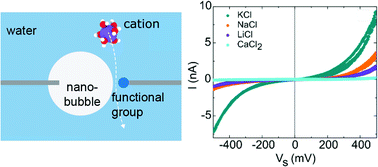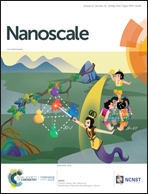Voltage gated inter-cation selective ion channels from graphene nanopores†
Abstract
With the ability to selectively control ionic flux, biological protein ion channels perform a fundamental role in many physiological processes. For practical applications that require the functionality of a biological ion channel, graphene provides a promising solid-state alternative, due to its atomic thinness and mechanical strength. Here, we demonstrate that nanopores introduced into graphene membranes, as large as 50 nm in diameter, exhibit inter-cation selectivity with a ∼20× preference for K+ over divalent cations and can be modulated by an applied gate voltage. Liquid atomic force microscopy of the graphene devices reveals surface nanobubbles near the pore to be responsible for the observed selective behavior. Molecular dynamics simulations indicate that translocation of ions across the pore likely occurs via a thin water layer at the edge of the pore and the nanobubble. Our results demonstrate a significant improvement in the inter-cation selectivity displayed by a solid-state nanopore device and by utilizing the pores in a de-wetted state, offers an approach to fabricate selective graphene membranes that does not rely on the fabrication of sub-nm pores.



 Please wait while we load your content...
Please wait while we load your content...
